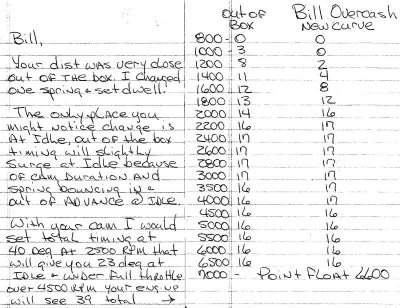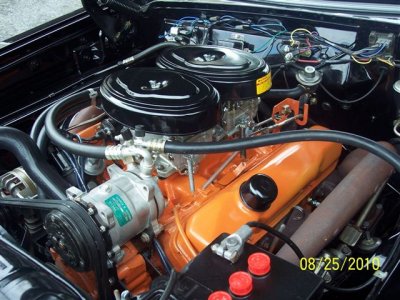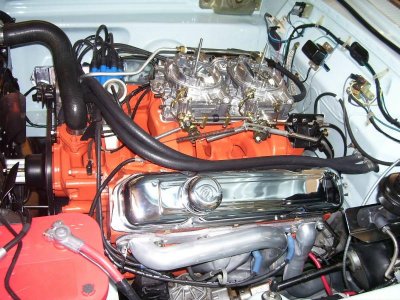SaskRunner
Well-Known Member
So what was the earliest Mopar to have ported vacuum to the distributor?
Good for you. Try teeing in a vacuum guage to your vacuum advance line and drive your car around. Tell me how much vacuum you have. Especially on deceleration, talk about retarded timing. And retarded at idle too. And manifold vacuum doesn't "retard" when opening the throttle, it drops back to where you want it so you are not over advanced. Like I said. Set your car up any way you want. I dont care.I disagree with post #7 and I don't care if Einstein wrote it. For clarification I believe ported vacuum is referred to as timed vacuum in this post. For a street car you want the ported port, which is really a manifold vacuum signal occurring above idle. I have experienced the timing retard using manifold vacuum as pointed out by A383.
thanks for the tip. i did fatten the carbs up a little and it made little to no difference. what did you end up for jetting? the ported/timed vacuum port is cruising at 18", under 2000rpm, and will go to 20" on deceleration. emissions or no emissions i've never had an issue with the timed port, until now.I had same issue with setting up my dual quads..same bucking & jerking at cruise and take off...turns out it was too lean
and vacuum advance only needed for acceleration & cruise...not needed at idle on a motor
thanks for the tip. i did fatten the carbs up a little and it made little to no difference. what did you end up for jetting? the ported/timed vacuum port is cruising at 18", under 2000rpm, and will go to 20" on deceleration. emissions or no emissions i've never had an issue with the timed port, until now.


Good for you. Try teeing in a vacuum guage to your vacuum advance line and drive your car around. Tell me how much vacuum you have. Especially on deceleration, talk about retarded timing. And retarded at idle too. And manifold vacuum doesn't "retard" when opening the throttle, it drops back to where you want it so you are not over advanced. Like I said. Set your car up any way you want. I dont care.
i've been trying different centrifugal curves and vacuum canisters without much luck. i just came back from a road test with a full centrifugal distributor and the car drove fine. i'm using a 1406 carb for the primary and noticed from my driving test there was little difference in vacuum between ported and manifold at low speed cruise. i think the problem for me is simply too strong of a vacuum signal at the timed port. i tried a restrictor and it made no difference. i have also noticed that the location of the timed port on the holley 6-pak i was using is in a different location than the 1406. the 1406 port is right at the throttle blade and the holley is further up the venturi. maybe using ported or manifold vacuum may depend more on the carb than other factors. right now i'll have to say that neither ported or manifold is the best in all circumstances. this mess sure makes me love the 6-pak even more. anyhow, thanks for your info and chiming in.Lew,
Recurved dual point tach drive ,ported vacuum and runs like a clock.Distributor was done by Paul Petcou in Michigan,this is what he does for a living plus engine work for fast class racing.Attached are specs,cam characteristics also play a big part in timing,no two are the same.View attachment 193101View attachment 193102
I notice I am seeing more and more guys running locked out dist and even some do it on the street. But it does depend on your combo as what works best for you. Ron
good info, this is basically what i do. i never toss the heavy spring. i think the conflict i'm having is a engine that wants to idle at 24-26 degrees intial and a carb with the timed port at the throttle blades and small venturi; this combo just doesn't mix well. a shorter cam with a wider LSA and slower centrifugal advance would work fine. i also think a holley carb, which isn't possible with the intake, would work.Heavily cammed you will need to crank in a lot of initial, maybe even lock it at full advance minus 2 degrees and let that heavy spring give you the rest over the RPM range. This will keep the weights under a load and prevent bouncing. Vac advance on a full lock out advance setup won't buy you anything IMO. If you don't need to lock it at full advance then maybe crank in 20 and limit the advance to give you the proper max advance and all in by maybe 2000 RPM. Ported vac advance might help you for cruising but beware of too much timing under load. The beauty of ported vac advance is the signal drops off as the throttle is opened more and more. Same with manifold vac but it doesn't affect your timing at idle.
mopar vacuum units are adjustable. more info your engine is needed.anyone have an opinion on the "heavily cammed engine" and the ECHLIN dist. vac. adv. Mr. Hinckley talks about? Clearly a chebby PN. but does MoPar make one? Adjustable?
Right now I have that situation and am running off the ported vacuum side. I'll play with it this weekend.

i agree with you. i was looking at some pre-emissions cars with carter afb's, non-mopar, and they used the timed port that is in the same location as mopar emision and pre-emission carters, plus the edelbrock stuff. for my 2 cents, work with the timed portThis has me all quite confused. I have read the blurb in post #7 twice....
Why would "timed" vacuum be considered an "emissions" compromise when my '62 (dual quad 300H motor) used it as well as every other old Mopar I ever owned? For lower emissions? I doubt it...
